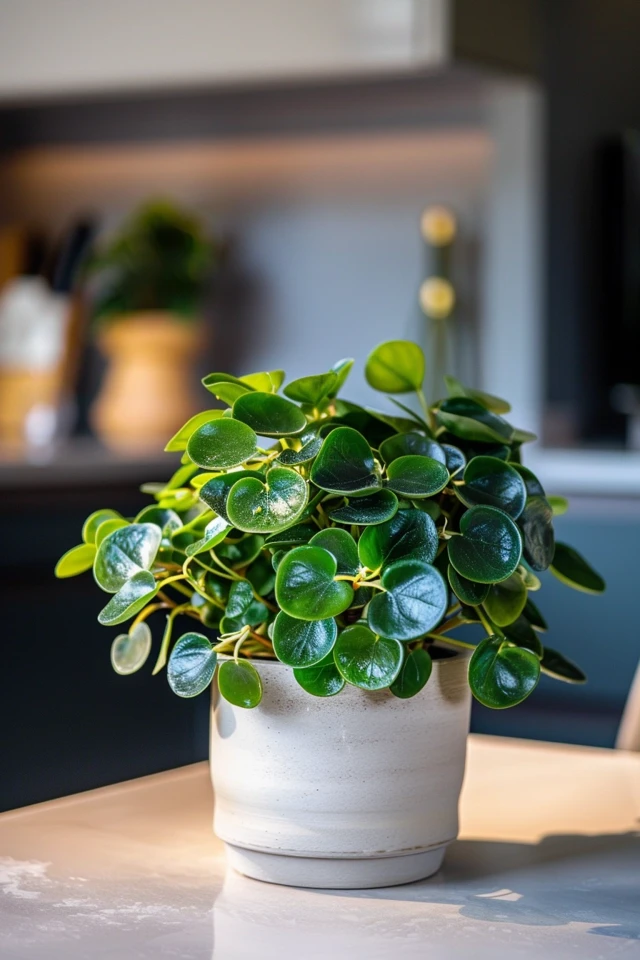Pruning is an essential part of caring for Peperomia plants. It helps maintain their vigor and aesthetics by removing leggy stems, rejuvenating the plant, and promoting bushier growth. The best time to prune Peperomia is when it starts looking dull, with leggy stems or brown, unhealthy leaves. Spring and summer are the ideal seasons for pruning, as it aligns with the plant’s growth spurt. Pruning after flowering is recommended to avoid removing potential blooms for the next season.
Sharp and clean pruning shears should be used for the process, making cuts just above leaf nodes to direct new growth. It’s important not to remove more than one-third of the plant at a time and to assess the shape periodically to maintain aesthetics. After pruning, the plant should be watered sparingly and given proper light to avoid sunburn. Growth may seem slow at first, but the plant will bounce back with fuller foliage.
Key Takeaways:
- Pruning Peperomia plants helps maintain their vigor and aesthetics.
- The best time to prune Peperomia is during spring and summer.
- Use sharp and clean pruning shears for the process.
- Make cuts just above leaf nodes to direct new growth.
- Avoid removing more than one-third of the plant at a time.

Pruning Techniques for Pincushion Peperomia
Best Practices for Pruning Peperomia, Trimming Peperomia Plants, Tips for Pruning Peperomia
When it comes to pruning Pincushion Peperomia, there are a few essential techniques to keep in mind. By following these best practices, you can ensure the health and vitality of your plant while maintaining its attractive appearance.
First and foremost, it’s crucial to select the right tools for the job. Sharp and clean pruning shears are a must-have for ensuring clean cuts and preventing damage to the plant. Before and after each use, make sure to disinfect the tools to minimize the risk of spreading diseases or pests.
When you begin the pruning process, the first step is to inspect the plant for dead, damaged, or diseased leaves. These should be carefully removed to promote new growth and prevent further spread of any issues. Use your pruning shears to make cuts just above leaf nodes, as this will encourage the plant to produce fresh growth in those areas.
While pruning, it’s important to remember not to remove more than one-third of the plant at a time. Removing too much foliage can shock the plant and hinder its ability to bounce back. Aim for a balanced approach, focusing on areas that need attention while maintaining the overall shape and structure of the Pincushion Peperomia.
To encourage bushier growth, you can consider pinching the stem tips during pruning. This simple technique stimulates new growth along the stems and results in a denser and more compact plant. Additionally, thinning out dense foliage and correcting any leggy growth can help maintain a well-shaped and aesthetically pleasing plant.
Periodically assess the shape of the plant to ensure symmetry and optimal air circulation. This will help prevent issues such as overcrowding and promote healthy growth. After pruning, be sure to water the plant carefully and monitor its progress closely for growth and overall health.
Basic Care and Common Mistakes to Avoid
Proper care is vital for the overall health and growth of your Peperomia plants. To ensure their well-being, it’s important to provide the right conditions. These plants thrive in medium to bright indirect light, making them perfect for indoor spaces. However, they should be protected from direct sunlight, as it can scorch their delicate leaves.
When it comes to soil, Peperomia plants prefer a loose and well-draining potting mix. This type of soil allows proper root aeration and prevents waterlogging, which can lead to root rot. To achieve the ideal moisture level, allow the soil to dry slightly between waterings. This will prevent overwatering and ensure the roots stay healthy.
In terms of temperature and humidity, Peperomia plants enjoy warm conditions and medium to high humidity. Aim to keep the room temperature between 65-80°F (18-27°C) and consider using a humidifier or placing a tray of water near the plant to increase humidity.

Fertilization should be done sparingly to avoid overfeeding your Peperomia plants. Organic options are recommended, as they provide a gentle and balanced nutrient boost. Regular monitoring for pests and diseases is crucial to catch any issues early on. Root rot and sap-sucking bugs are common challenges, but with careful observation and appropriate treatments, you can keep your plants healthy and pest-free.
After pruning, post-pruning care is essential. This includes ensuring adequate watering, providing the right amount of light exposure, and monitoring for any signs of stress or disease. By avoiding common mistakes such as over-pruning, cutting in the wrong place, overwatering, and neglecting pest control, you can maintain your Peperomia plants’ health and enjoy their beautifully ornamental foliage for years to come.

